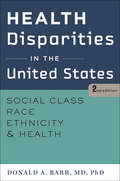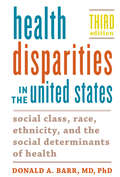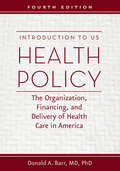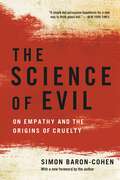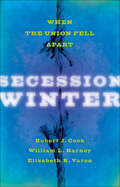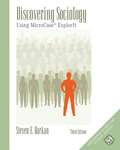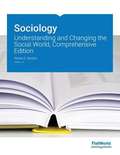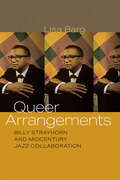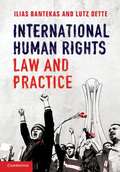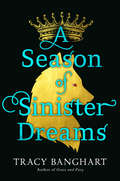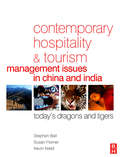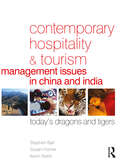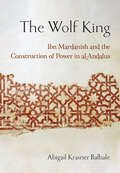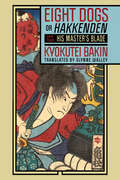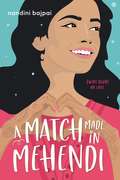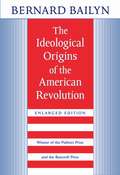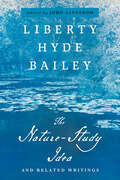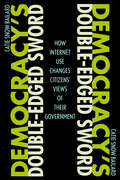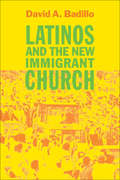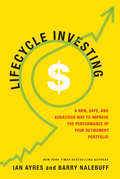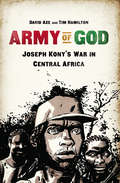- Table View
- List View
Health Disparities in the United States: Social Class, Race, Ethnicity, and Health
by Donald A. BarrOutstanding Academic Title, Choice magazineThe health care system in the United States has been called the best in the world. Yet wide health disparities persist between different social groups, and many Americans suffer from poorer health than people in other developed countries. Donald A. Barr's Health Disparities in the United States explores how socioeconomic status, race, and ethnicity interact with socioeconomic inequality to create and perpetuate these health disparities. Examining the significance of this gulf for the medical community, cultural subsets, and society at large, Barr offers potential policy- and physician-based solutions for reducing health inequity in the long term.This popular course book, which has been fully updated, now incorporates significant new material, including a chapter on the profound effects of inequality on child development, behavioral choices, and adult health status. An essential text for courses in public health, health policy, and sociology, the second edition analyzes the complex web of social forces that influence health outcomes in the United States. This book is a vital teaching tool and a comprehensive reference for social science and medical professionals.
Health Disparities in the United States: Social Class, Race, Ethnicity, and the Social Determinants of Health
by Donald A. BarrThe health care system in the United States has been called the best in the world. Yet wide disparities persist between social groups, and many Americans suffer from poorer health than people in other developed countries. In this revised edition of Health Disparities in the United States, Donald A. Barr provides extensive new data about the ways low socioeconomic status, race, and ethnicity interact to create and perpetuate these health disparities. Examining the significance of this gulf for the medical community and society at large, Barr offers potential policy- and physician-based solutions for reducing health inequity in the long term.This thoroughly updated edition focuses on a new challenge the United States last experienced more than half a century ago: successive years of declining life expectancy. Barr addresses the causes of this decline, including what are commonly referred to as "deaths of despair"—from opiate overdose or suicide. Exploring the growing role geography plays in health disparities, Barr asks why people living in rural areas suffer the greatest increases in these deaths. He also analyzes recent changes under the Affordable Care Act and considers the literature on how race and ethnicity affect the way health care providers evaluate and treat patients.As both a physician and a sociologist, Barr is uniquely positioned to offer rigorous medical explanations alongside sociological analysis. An essential text for courses in public health, health policy, and sociology, this compelling book is a vital teaching tool and a comprehensive reference for social science and medical professionals.
Health Disparities in the United States: Social Class, Race, Ethnicity, and the Social Determinants of Health
by Donald A. BarrThe health care system in the United States has been called the best in the world. Yet wide disparities persist between social groups, and many Americans suffer from poorer health than people in other developed countries. In this revised edition of Health Disparities in the United States, Donald A. Barr provides extensive new data about the ways low socioeconomic status, race, and ethnicity interact to create and perpetuate these health disparities. Examining the significance of this gulf for the medical community and society at large, Barr offers potential policy- and physician-based solutions for reducing health inequity in the long term.This thoroughly updated edition focuses on a new challenge the United States last experienced more than half a century ago: successive years of declining life expectancy. Barr addresses the causes of this decline, including what are commonly referred to as "deaths of despair"—from opiate overdose or suicide. Exploring the growing role geography plays in health disparities, Barr asks why people living in rural areas suffer the greatest increases in these deaths. He also analyzes recent changes under the Affordable Care Act and considers the literature on how race and ethnicity affect the way health care providers evaluate and treat patients.As both a physician and a sociologist, Barr is uniquely positioned to offer rigorous medical explanations alongside sociological analysis. An essential text for courses in public health, health policy, and sociology, this compelling book is a vital teaching tool and a comprehensive reference for social science and medical professionals.
Introduction to US Health Policy: The Organization, Financing, and Delivery of Health Care in America
by Donald A. BarrHealth care reform has been a dominant theme in public discourse for decades now. The passage of the Affordable Care Act was a major milestone, but rather than quell the rhetoric, it has sparked even more heated debate. In the latest edition of Introduction to US Health Policy, Donald A. Barr reviews the current structure of the American health care system, describing the historical and political contexts in which it developed and the core policy issues that continue to confront us today.Barr;€™s comprehensive analysis explores the various organizations and institutions that make the US health care system work;¢;‚¬;€?or fail to work. He describes in detail the paradox of US health care;¢;‚¬;€?simultaneously the best in the world and one of the worst among developed countries;¢;‚¬;€?while introducing readers to broad cultural issues surrounding health care policy, such as access, affordability, and quality. Barr also discusses specific elements of US health care with depth and nuance, including insurance, especially Medicare and Medicaid. He scrutinizes the shift to for-profit managed care while analyzing the pharmaceutical industry, issues surrounding long-term care, the plight of the uninsured, the prevalence of medical errors, and the troublesome issue of nursing shortages. The thoroughly updated edition of this widely adopted text focuses on the Affordable Care Act. It explains the steps taken to carry out the Act, the changes to the Act based on recent Supreme Court decisions, the success of the Act in achieving the combined goals of improved access to care and constraining the costs of care, and the continuing political controversy regarding its future. Drawing on an extensive range of resources, including government reports, scholarly publications, and analyses from a range of private organizations, Introduction to US Health Policy provides scholars, policymakers, and health care providers with a comprehensive platform of ideas that is key to understanding and influencing the changes in the US health care system.
Introduction to US Health Policy: The Organization, Financing, and Delivery of Health Care in America
by Donald A. BarrHealth care reform has been a dominant theme in public discourse for decades now. The passage of the Affordable Care Act was a major milestone, but rather than quell the rhetoric, it has sparked even more heated debate. In the latest edition of Introduction to US Health Policy, Donald A. Barr reviews the current structure of the American health care system, describing the historical and political contexts in which it developed and the core policy issues that continue to confront us today.Barr;€™s comprehensive analysis explores the various organizations and institutions that make the US health care system work;¢;‚¬;€?or fail to work. He describes in detail the paradox of US health care;¢;‚¬;€?simultaneously the best in the world and one of the worst among developed countries;¢;‚¬;€?while introducing readers to broad cultural issues surrounding health care policy, such as access, affordability, and quality. Barr also discusses specific elements of US health care with depth and nuance, including insurance, especially Medicare and Medicaid. He scrutinizes the shift to for-profit managed care while analyzing the pharmaceutical industry, issues surrounding long-term care, the plight of the uninsured, the prevalence of medical errors, and the troublesome issue of nursing shortages. The thoroughly updated edition of this widely adopted text focuses on the Affordable Care Act. It explains the steps taken to carry out the Act, the changes to the Act based on recent Supreme Court decisions, the success of the Act in achieving the combined goals of improved access to care and constraining the costs of care, and the continuing political controversy regarding its future. Drawing on an extensive range of resources, including government reports, scholarly publications, and analyses from a range of private organizations, Introduction to US Health Policy provides scholars, policymakers, and health care providers with a comprehensive platform of ideas that is key to understanding and influencing the changes in the US health care system.
The Science of Evil: On Empathy and the Origins of Cruelty
by Simon Baron-CohenA groundbreaking and challenging examination of the social, cognitive, neurological, and biological roots of psychopathy, cruelty, and evilBorderline personality disorder, autism, narcissism, psychosis: All of these syndromes have one thing in common--lack of empathy. In some cases, this absence can be dangerous, but in others it can simply mean a different way of seeing the world.In The Science of Evil Simon Baron-Cohen, an award-winning British researcher who has investigated psychology and autism for decades, develops a new brain-based theory of human cruelty. A true psychologist, however, he examines social and environmental factors that can erode empathy, including neglect and abuse.Based largely on Baron-Cohen's own research, The Science of Evil will change the way we understand and treat human cruelty.
Secession Winter: When the Union Fell Apart (The Marcus Cunliffe Lecture Series)
by William L. Barney Robert J. Cook Elizabeth R. VaronPoliticians and opinion leaders on both sides of the Mason-Dixon line struggled to formulate coherent responses to the secession of the deep South states. The Confederate attack on Fort Sumter in mid-April 1861 triggered civil war and the loss of four upper South states from the Union. The essays by three senior historians in Secession Winter explore the robust debates that preceded these events.For five months in the winter of 1860–1861, Americans did not know for certain that civil war was upon them. Some hoped for a compromise; others wanted a fight. Many struggled to understand what was happening to their country. Robert J. Cook, William L. Barney, and Elizabeth R. Varon take approaches to this period that combine political, economic, and social-cultural lines of analysis. Rather than focus on whether civil war was inevitable, they look at the political process of secession and find multiple internal divisions—political parties, whites and nonwhites, elites and masses, men and women. Even individual northerners and southerners suffered inner conflicts. The authors include the voices of Unionists and Whig party moderates who had much to lose and upcountry folk who owned no slaves and did not particularly like those who did. Barney contends that white southerners were driven to secede by anxiety and guilt over slavery. Varon takes a new look at Robert E. Lee's decision to join the Confederacy. Cook argues that both northern and southern politicians claimed the rightness of their cause by constructing selective narratives of historical grievances. Secession Winter explores the fact of contingency and reminds readers and students that nothing was foreordained.
Sociology
by Steven E. BarkanThis best selling software-based workbook lets students explore dozens of sociological topics and issues, using data from the United States and around the world. With the workbook and accompanying ExplorIt software and data sets, students won't just read about what other sociologists have done, they will discover sociology for themselves. DISCOVERING SOCIOLOGY will add an exciting dimension to the introductory sociology course.
Sociology: Understanding and Changing the Social World
by Steven E. BarkanThe founders of sociology in the United States wanted to make a difference. A central aim of the sociologists of the Chicago school was to use sociological knowledge to achieve social reform. A related aim of sociologists like Jane Addams, W.E.B. DuBois, and Ida B. Wells-Barnett and others since was to use sociological knowledge to understand and alleviate gender, racial, and class inequality. It is no accident that many sociology instructors and students are first drawn to sociology because they want to learn a body of knowledge that could help them make a difference in the world at large. Steve Barkan's Sociology: Understanding and Changing the Social World is designed for this audience. It presents a sociological understanding of society but also a sociological perspective on how to change society, while maintaining the structure and contents of the best mainstream texts.
Queer Arrangements: Billy Strayhorn and Midcentury Jazz Collaboration (Music / Culture)
by Lisa BargThe legacy of Black queer composer, arranger, and pianist Billy Strayhorn (1915–1967) hovers at the edge of canonical jazz narratives. Queer Arrangements explores the ways in which Strayhorn's identity as an openly gay Black jazz musician shaped his career, including the creative roles he could assume and the dynamics between himself and his collaborators, most famously Duke Ellington, but also iconic singers such as Lena Horne and Ella Fitzgerald. This new portrait of Strayhorn combines critical, historically-situated close readings of selected recordings, scores, and performances with biography and cultural theory to pursue alternative interpretive jazz possibilities, Black queer historical routes, and sounds. By looking at jazz history through the instrument(s) of Strayhorn's queer arrangements, this book sheds new light on his music and on jazz collaboration at midcentury.
Risk Management for Enterprises and Individuals
by Etti Baranoff Patrick Lee Brockett Yehuda KahaneThis book is intended for the Risk Management and Insurance course where Risk Management is emphasized. When we think of large risks, we often think in terms of natural hazards such as hurricanes, earthquakes or tornados. Perhaps man-made disasters come to mind such as the terrorist attacks in the U.S. on September 11, 2001. Typically we have overlooked financial crises, such as the credit crisis of 2008. However, these types of man-made disasters have the potential to devastate the global marketplace. Losses in multiple trillions of dollars and in much human suffering and insecurity are already being totaled, and the global financial markets are collapsing as never before seen. We can attribute the 2008 collapse to financially risky behavior of a magnitude never before experienced. The 2008 U.S. credit markets were a financial house of cards. A basic lack of risk management (and regulators' inattention or inability to control these overt failures) lay at the heart of the global credit crisis. This crisis started with lack of improperly underwritten mortgages and excessive debt. Companies depend on loans and lines of credit to conduct their routine business. If such credit lines dry up, production slows down and brings the global economy to the brink of deep recession or even depression. The snowballing effect of this failure to manage the risk associated with providing mortgage loans to unqualified home buyers have been profound, indeed. When the mortgages failed because of greater risk- taking on the Street, the entire house of cards collapsed. Probably no other risk-related event has had, and will continue to have, as profound an impact world wide as this risk management failure. How was risk in this situation so badly managed? What could firms and individuals have done to protect themselves? How can government measure such risks (beforehand) to regulate and control them? These and other questions come to mind when we contemplate the consequences of this risk management fiasco. Standard risk management practice would have identified sub-prime mortgages and their bundling into mortgage-backed-securities as high risk. People would have avoided these investments or would have put enough money into reserve to be able to withstand defaults. This did not happen. Accordingly, this book may represent one of the most critical topics of study that the student of the 21st century could ever undertake. Risk management will be a major focal point of business and societal decision making in the 21st century. A separate focused field of study, it draws on core knowledge bases from law, engineering, finance, economics, medicine, psychology, accounting, mathematics, statistics and other fields to create a holistic decision-making framework that is sustainable and value- enhancing. This is the subject of this book.
International Human Rights Law and Practice (PDF)
by Ilias Bantekas Oette LutzThis innovative textbook explores human rights law from a theoretical and practical perspective. Case studies and interviews with specialists show how theory is applied in real life and discussion questions engage students. The authors' talent for critical analysis and clarification make this an essential student text. Human rights law is a complex but compelling subject that fascinates students but also confuses them. This innovative textbook explores human rights law from a theoretical and practical perspective. Case studies and interviews with specialist practitioners, NGO activists and policy-makers show how theory is applied in real life. The up-to-date coverage includes introductions to important emerging fields such as globalisation, poverty and advocacy. Student learning is supported by questions to stimulate seminar discussion and further reading sections that encourage independent study. The authors' combined expertise, engaging writing style and ability to clarify not simplify ensures that this important new book will become required reading for all students of human rights law.
A Season of Sinister Dreams
by Tracy BanghartFuryborn meets A Curse So Dark and Lonely in this thrilling fantasy about two powerful girls coming together to protect their beloved kingdom—from the author of Grace and Fury. Annalise may be cousin to the prince, but her past isn't what she claims, and she possesses a magic so powerful it takes all her strength to control it. Evra is a country girl, and has watched as each friend and family member came into their own magic, while hers remains dormant. But everything changes after Annalise loses control of herself and Evra begins experiencing the debilitating visions of a once-in-a-generation clairvoyant meant to serve the crown. Thrown together at court, Evra and Annalise find that they have the same goal: to protect their kingdom from the powerful men who are slowly destroying it. But neither is quick to trust the other—Evra's visions suggest a threat to royal rule, and Annalise worries that her darkest secrets will be revealed. Their magic at odds, the young women circle each other, until the truth must come out. Full of intrigue, romance, and shocking twists, this gorgeously immersive fantasy will keep readers spellbound until the very last page.
Contemporary Hospitality and Tourism Management Issues in China and India: Today's Dragons and Tigers (1st Edition) (PDF)
by Stephen Ball Kevin Nield Susan HornerThis book represents a comprehensive, authoritative and up-to-date analysis of key sectors in the hospitality and tourism industries in China and India, and will address the market's growing need for information on Tourism in China and India. The text will be written in an accessible style drawing on the authors' wealth of theoretical, educational and industry experience. The text will contain inputs from academic colleagues and commercial contacts from the identified region. Case studies will give real life experiences of hospitality and tourism companies and organisations operating in this region and will include interactive exercises and discussion points.
Contemporary Hospitality and Tourism Management Issues in China and India: Today's Dragons and Tigers (1st Edition)
by Stephen Ball Kevin Nield Susan HornerThis book represents a comprehensive, authoritative and up-to-date analysis of key sectors in the hospitality and tourism industries in China and India, and will address the market's growing need for information on Tourism in China and India. The text will be written in an accessible style drawing on the authors' wealth of theoretical, educational and industry experience. The text will contain inputs from academic colleagues and commercial contacts from the identified region. Case studies will give real life experiences of hospitality and tourism companies and organisations operating in this region and will include interactive exercises and discussion points.
The Wolf King: Ibn Mardanish and the Construction of Power in al-Andalus (Medieval Societies, Religions, and Cultures)
by Abigail Krasner BalbaleThe Wolf King explores how political power was conceptualized, constructed, and wielded in twelfth-century al-Andalus, focusing on the eventful reign of Muhammad ibn Sad ibn Ahmad ibn Mardanīsh (r. 1147–1172). Celebrated in Castilian and Latin sources as el rey lobo/rex lupus and denigrated by Almohad and later Arabic sources as irreligious and disloyal to fellow Muslims because he fought the Almohads and served as vassal to the Castilians, Ibn Mardanīsh ruled a kingdom that at its peak constituted nearly half of al-Andalus and served as an important buffer between the Almohads and the Christian kingdoms of Castile and Aragon.Through a close examination of contemporary sources across the region, Abigail Krasner Balbale shows that Ibn Mardanīsh's short-lived dynasty was actually an attempt to integrate al-Andalus more closely with the Islamic East—particularly the Abbasid caliphate. At stake in his battles against the Almohads was the very idea of the caliphate in this period, as well as who could define righteous religious authority. The Wolf King makes effective use of chronicles, chancery documents, poetry, architecture, coinage, and artifacts to uncover how Ibn Mardanīsh adapted language and cultural forms from around the Islamic world to assert and consolidate power—and then tracks how these strategies, and the memory of Ibn Mardanīsh more generally, influenced expressions of kingship in subsequent periods.
Eight Dogs, or "Hakkenden": Part Two—His Master's Blade
by Kyokutei BakinKyokutei Bakin's Nansō Satomi Hakkenden is one of the monuments of Japanese literature. This multigenerational samurai saga was one of the most popular and influential books of the nineteenth century and has been adapted many times into film, television, fiction, and comics.His Master's Blade, the second part of Hakkenden, begins the story of the eight Dog Warriors created from the mystic union between Princess Fuse and the dog Yatsufusa and born into eight different samurai families in fifteenth-century Japan. The first is Inuzuka Shino, orphaned descendent of proud warriors. Left with nothing save a magical sword and the bead that marks him as a Dog Warrior, young Shino escapes his evil aunt and uncle and sets out to restore his family name. Unaware of their karmic bond, Shino and the other Dog Warriors are drawn into a world of vendettas and quests, gallants, and rogues, as each strives to learn his true nature and find his place in the eight-man fraternity.
A Match Made in Mehendi
by Nandini BajpaiFor fans of Brandy Colbert and Jenny Han comes a lighthearted novel about tradition, high school social hierarchy, matchmaking, and swiping right (or left!) Fifteen-year-old Simran "Simi" Sangha comes from a long line of Indian vichole -- matchmakers -- with a rich history for helping parents find good matches for their grown children. When Simi accidentally sets up her cousin and a soon-to-be lawyer, her family is thrilled that she has the "gift."But Simi is an artist, and she doesn't want to have anything to do with relationships, helicopter parents, and family drama. That is, until she realizes this might be just the thing to improve her and her best friend Noah's social status. Armed with her family's ancient guide to finding love, Simi starts a matchmaking service -- via an app, of course.But when she helps connect a wallflower of a girl with the star of the boys' soccer team, she turns the high school hierarchy topsy-turvy, soon making herself public enemy number one.
Ideological Origins of the American Revolution (PDF)
by Bernard BailynIn this 25th anniversary edition, Bailyn has added a substantial essay, Fulfillment, as a Postscript to the original text. In it he discusses the intense, nation-wide debate on the ratification of the constitution, stressing the continuities between that struggle over the foundations of the national government and the original principles of the Revolution. This study of the persistence of the nation's ideological origins adds a new dimension to the book and projects its meaning forward into vital present concerns.;Bailyn is author of The Ordeal of Thomas Hutchinson which won the National Book Award and Voyagers to the West which won the Pulitzer Prize for History.
The Nature-Study Idea: And Related Writings (The Liberty Hyde Bailey Library)
by Liberty Hyde BaileyIn The Nature-Study Idea, Liberty Hyde Bailey articulated the essence of a social movement, led by ordinary public-school teachers, that lifted education out of the classroom and placed it into firsthand contact with the natural world. The aim was simple but revolutionary: sympathy with nature to increase the joy of living and foster stewardship of the earth.With this definitive edition, John Linstrom reintroduces The Nature-Study Idea as an environmental classic for our time. It provides historical context through a wealth of related writings, and introductory essays relate Bailey's vision to current work in education and the intersection of climate change and culture. In this period of planetary turmoil, Bailey's ambition to cultivate wonder (in adults as well as children) and lead readers back into the natural world is more important than ever.
Democracy's Double-Edged Sword: How Internet Use Changes Citizens' Views of Their Government
by Catie Snow BailardThe beauty of democracy is not only that citizens can vote a candidate into office but that they can also vote one out. As digital media grows omnipresent, it becomes more important for political scientists and communication scholars to understand its influence on all aspects of the political process, from campaigning to governance. Catie Snow Bailard argues that the Internet—by altering the quantity and range of information available to citizens—directly influences the ability of individuals to evaluate government performance. It also affects public satisfaction with the quality of available democratic practices and helps motivate political activity and organization.Bailard originates two theories for democratization specialists to consider—mirror-holding and window-opening—which she tests using data collected from dozens of countries and two randomized field experiments. Mirror-holding explores how accessing the Internet allows citizens to see a more detailed and nuanced view of their own government’s performance. Window-opening, however, enables those same citizens to glimpse how other governments perform, particularly in comparison to their own.Although the book offers a robust empirical foundation for testing the Internet’s effects on democratic attitudes, Bailard ultimately concludes that access to information does not necessarily ensure that democracy will automatically flourish.
Democracy's Double-Edged Sword: How Internet Use Changes Citizens' Views of Their Government
by Catie Snow BailardThe beauty of democracy is not only that citizens can vote a candidate into office but that they can also vote one out. As digital media grows omnipresent, it becomes more important for political scientists and communication scholars to understand its influence on all aspects of the political process, from campaigning to governance. Catie Snow Bailard argues that the Internetâ€�by altering the quantity and range of information available to citizensâ€�directly influences the ability of individuals to evaluate government performance. It also affects public satisfaction with the quality of available democratic practices and helps motivate political activity and organization.Bailard originates two theories for democratization specialists to considerâ€�mirror-holding and window-openingâ€�which she tests using data collected from dozens of countries and two randomized field experiments. Mirror-holding explores how accessing the Internet allows citizens to see a more detailed and nuanced view of their own government’s performance. Window-opening, however, enables those same citizens to glimpse how other governments perform, particularly in comparison to their own.Although the book offers a robust empirical foundation for testing the Internet’s effects on democratic attitudes, Bailard ultimately concludes that access to information does not necessarily ensure that democracy will automatically flourish.
Latinos and the New Immigrant Church
by David A. BadilloLatin Americans make up the largest new immigrant population in the United States, and Latino Catholics are the fastest-growing sector of the Catholic Church in America. In this book, historian David A. Badillo offers a history of Latino Catholicism in the United States by looking at its growth in San Antonio, Chicago, New York, and Miami. Focusing on twentieth-century Latino urbanism, Badillo contrasts broad historic commonalities of Catholic religious tradition with variations of Latino ethnicity in various locales. He emphasizes the contours of day-to-day life as well as various aspects of institutional and lived Catholicism. The story of Catholicism goes beyond clergy and laity; it entails the entire urban experience of neighborhoods, downtown power seekers, archdiocesan movers and shakers, and a range of organizations and associations linked to parishes. Although parishes remain the key site for Latino efforts to build individual and cultural identities, Badillo argues that one must consider simultaneously the triad of parish, city, and ethnicity to fully comprehend the influence of various Latino populations on both Catholicism and the urban environment in the United States.By contrasting the development of three distinctive Latino communities—the Mexican Americans, Puerto Ricans, and Cuban Americans—Badillo challenges the popular concept of an overarching "Latino experience" and offers instead an integrative approach to understanding the scope, depth, and complexity of the Latino contribution to the character of America's urban landscapes.
Lifecycle Investing: A New, Safe, and Audacious Way to Improve the Performance of Your Retirement Portfolio
by Ian Ayres Barry NalebuffDiversification provides a well-known way of getting something close to a free lunch: by spreading money across different kinds of investments, investors can earn the same return with lower risk (or a much higher return for the same amount of risk). This strategy, introduced nearly fifty years ago, led to such strategies as index funds. What if we were all missing out on another free lunch that&’s right under our noses? In Lifecycle Investing, Barry Nalebuff and Ian Ayres—two of the most innovative thinkers in business, law, and economics—have developed tools that will allow nearly any investor to diversify their portfolios over time. By using leveraging when young—a controversial idea that sparked hate mail when the authors first floated it in the pages of Forbes—investors of all stripes, from those just starting to plan to those getting ready to retire, can substantially reduce overall risk while improving their returns. In Lifecycle Investing, readers will learnHow to figure out the level of exposure and leverage that&’s right for youHow the Lifecycle Investing strategy would have performed in the historical marketWhy it will work even if everyone does itWhen not to adopt the Lifecycle Investing strategy Clearly written and backed by rigorous research, Lifecycle Investing presents a simple but radical idea that will shake up how we think about retirement investing even as it provides a healthier nest egg in a nicely feathered nest.
Army of God: Joseph Kony's War in Central Africa
by David Axe Tim HamiltonJoseph Kony is the most dangerous guerilla leader in modern African history.It started with a visit from spirits. In 1991, Kony claimed that spiritual beings had come to him with instructions: he was to lead his group of rebels, the Lord's Resistance Army, in a series of brutal raids against ordinary Ugandan civilians. Decades later, Kony has sown chaos throughout Central Africa, kidnapping and terrorizing countless innocents—especially children. Yet despite an enormous global outcry, the Kony 2012 movement, and an international military intervention, the carnage has continued. Drawn from on-the-ground reporting by war correspondent David Axe and starkly illustrated by Tim Hamilton, Army of God is the first-ever graphic account of the global phenomenon surrounding Kony—from the devastation he has left behind to the long campaign to defeat him for good.
